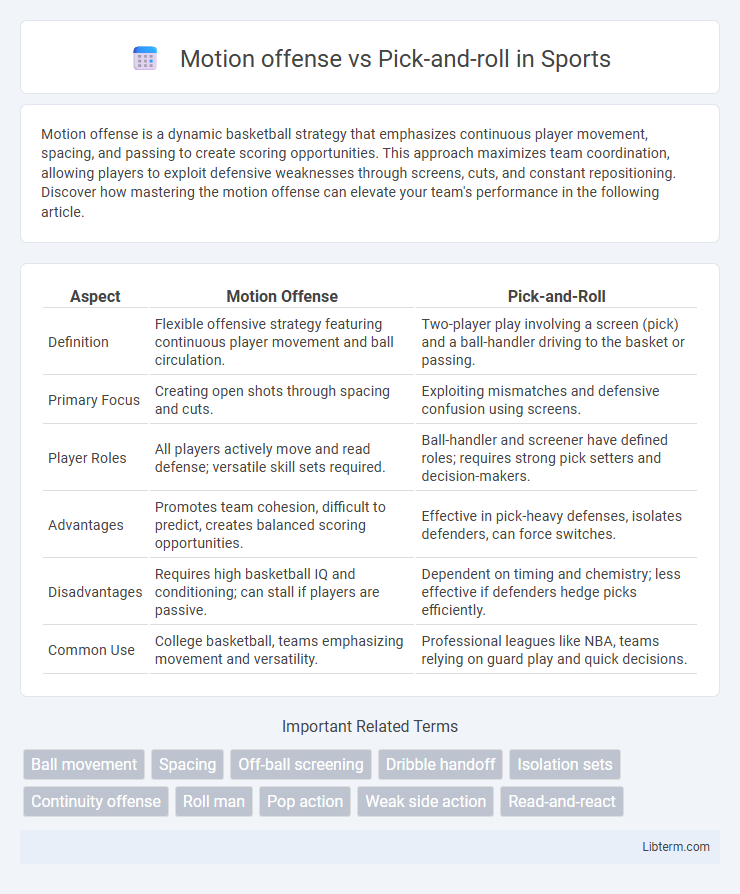Motion offense is a dynamic basketball strategy that emphasizes continuous player movement, spacing, and passing to create scoring opportunities. This approach maximizes team coordination, allowing players to exploit defensive weaknesses through screens, cuts, and constant repositioning. Discover how mastering the motion offense can elevate your team's performance in the following article.
Table of Comparison
| Aspect | Motion Offense | Pick-and-Roll |
|---|---|---|
| Definition | Flexible offensive strategy featuring continuous player movement and ball circulation. | Two-player play involving a screen (pick) and a ball-handler driving to the basket or passing. |
| Primary Focus | Creating open shots through spacing and cuts. | Exploiting mismatches and defensive confusion using screens. |
| Player Roles | All players actively move and read defense; versatile skill sets required. | Ball-handler and screener have defined roles; requires strong pick setters and decision-makers. |
| Advantages | Promotes team cohesion, difficult to predict, creates balanced scoring opportunities. | Effective in pick-heavy defenses, isolates defenders, can force switches. |
| Disadvantages | Requires high basketball IQ and conditioning; can stall if players are passive. | Dependent on timing and chemistry; less effective if defenders hedge picks efficiently. |
| Common Use | College basketball, teams emphasizing movement and versatility. | Professional leagues like NBA, teams relying on guard play and quick decisions. |
Introduction to Motion Offense and Pick-and-Roll
Motion offense is a basketball strategy emphasizing continuous player movement, ball circulation, and backdoor cuts to create open shots and exploit defensive lapses. The pick-and-roll is a dynamic offensive play involving a screen set by a teammate (the pick) to free the ball-handler, who then chooses to shoot, pass, or drive based on the defense's reaction. Both techniques prioritize spacing and decision-making but differ in execution, with motion offense relying on fluid teamwork and pick-and-roll focusing on two-player coordination to generate scoring opportunities.
Core Principles of Motion Offense
The core principles of a motion offense emphasize continuous player movement, spacing, and passing to create open scoring opportunities through cuts, screens, and reads rather than relying on set plays. This offensive strategy promotes reading the defense and making decisions based on positioning, exploiting defensive weaknesses by maintaining constant motion and balance. Unlike the pick-and-roll, which focuses on a two-player interaction between the ball-handler and screener, the motion offense leverages team dynamics and collective positioning to generate diverse scoring chances.
Fundamentals of Pick-and-Roll Offense
The fundamentals of the pick-and-roll offense center on precise timing, effective screen setting, and sharp ball-handling to create scoring opportunities. Players must master footwork and decision-making to exploit defensive mismatches and open lanes. Coordination between the ball-handler and screener is crucial for executing quick passes, drives, or shots against varying defensive coverages.
Key Differences Between Motion Offense and Pick-and-Roll
The Motion offense emphasizes player movement, spacing, and ball circulation to create open shot opportunities, relying on continuous cuts and screens without set patterns. In contrast, the Pick-and-roll centers on a two-player action where the ball handler uses a screen from a teammate to exploit defensive mismatches and generate scoring chances. Motion offense promotes team versatility and unpredictability, while Pick-and-roll focuses on isolation plays driven by defender reactions to the screen.
Advantages of Motion Offense in Basketball
Motion offense in basketball offers superior spacing and player movement, enabling versatile scoring opportunities through continuous cuts and screens. It prioritizes team collaboration, reducing predictability and adapting dynamically to defensive adjustments. This system enhances player decision-making and maximizes offensive efficiency by exploiting defensive mismatches without relying heavily on set plays like the pick-and-roll.
Strengths of Pick-and-Roll Offense
The pick-and-roll offense leverages coordinated screen-setting and quick decision-making to create high-percentage scoring opportunities through mismatches and open lanes. This strategy enhances team spacing and forces defenses into difficult rotations, increasing the chance of defensive breakdowns. Its adaptability against various defensive schemes makes it a staple in both professional and collegiate basketball offenses.
Common Challenges and Drawbacks
Motion offense challenges include high reliance on player decision-making, which can lead to inconsistent execution and defensive breakdowns. Pick-and-roll drawbacks often involve predictable patterns that allow defenses to anticipate and counter effectively, especially if the screener or ball-handler lacks versatility. Both strategies require precise timing and communication, making misalignment a frequent source of turnover or missed scoring opportunities.
Best Situations to Use Motion Offense
Motion offense excels in creating open lanes through continuous player movement and ball passing, making it ideal against aggressive man-to-man defenses. It thrives when facing teams with strong shot-blockers or zone defenses that limit pick-and-roll effectiveness. Using motion offense in late-game situations helps exploit defensive lapses and generates high-quality perimeter shots.
When to Deploy Pick-and-Roll Strategies
Pick-and-roll strategies are most effective against defenses that struggle with communication and quick rotations, exploiting mismatches and creating open lanes for ball handlers or roll men. Deploying pick-and-roll actions in late-game situations or shot clock scenarios leverages its ability to generate high-percentage scoring opportunities under pressure. Teams facing aggressive on-ball defenders often use pick-and-rolls to force switches, disrupt defensive schemes, and create favorable offensive mismatches.
Choosing the Right Offense for Your Team
Selecting the right offense depends on your team's strengths and player skills, with motion offense emphasizing continuous player movement and ball circulation to create open shots, while pick-and-roll relies on effective screen-setting and coordination between the ball-handler and screener. Teams with versatile, skilled passers and cutters may excel in motion offense, promoting balanced scoring and defensive pressure. Conversely, teams featuring strong ball-handlers and agile screeners might prefer pick-and-roll strategies to exploit mismatches and generate pick-driven scoring opportunities.
Motion offense Infographic

 libterm.com
libterm.com